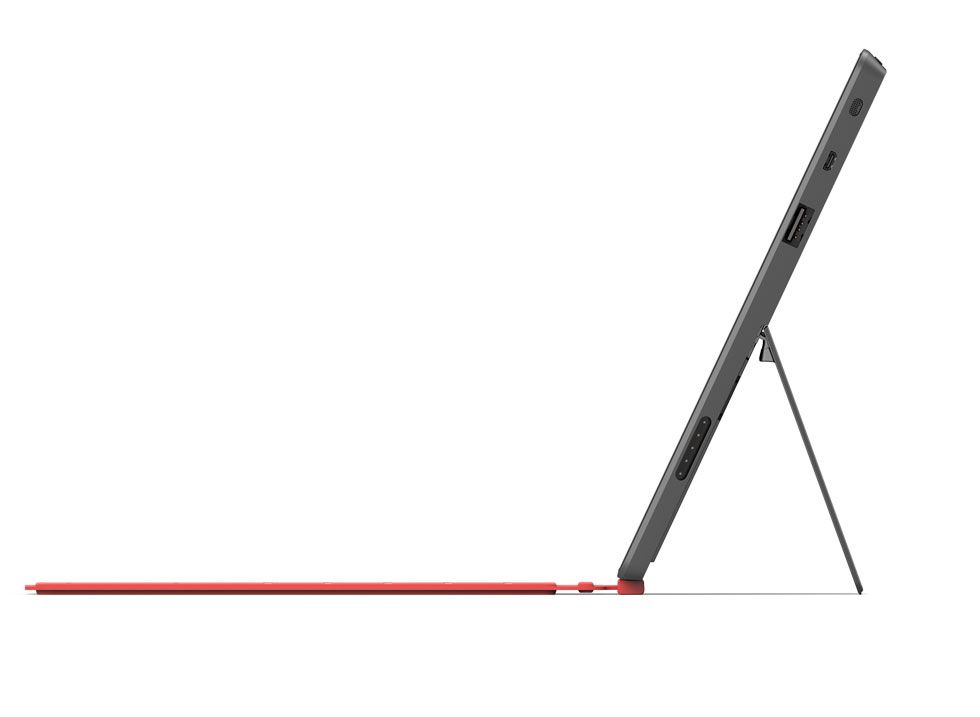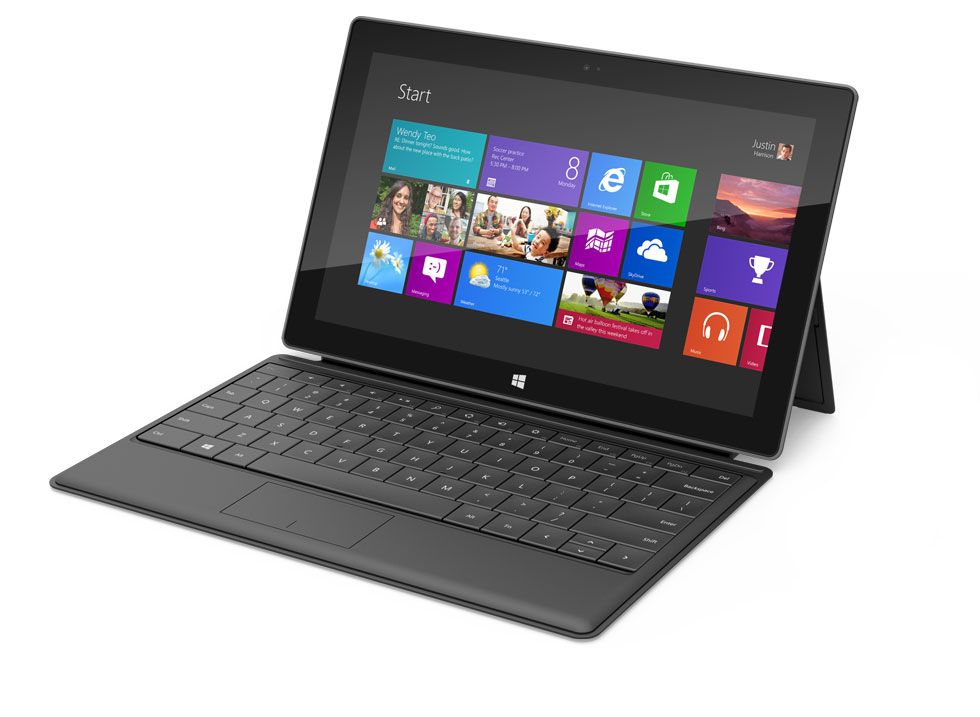Microsoft is entering the tablet space with its own line of hardware. Microsoft Surface tablets will come in two versions. There will be Windows RT model with an ARM-based processor for light weight and long battery life, and an Intel powered model with which can run all Windows 8 apps, as well as software designed for earlier version of Windows.

Both tablets will feature 10.6 inch HD displays with Gorilla Glass. They’ll each feature a built-in kickstand, a magnesium case, a strong wireless antenna, front and rear cameras, and magnets which let you snap on a cover — which can also function as a keyboard thanks to built-in multitouch keyboard support in the 3mm (0.12 inch) thick cover.
If you prefer physical keys with tactile feedback, Microsoft will also offer a product called the Type Cover which looks like a slightly thicker cover with a built-in keyboard and touchpad.
The Microsoft Surface Windows RT tablet will be thinner and lighter, at 0.37 inches thick and 1.5 pounds. It has a 31.5 Whr battery, a microSD card slot, USB 2.0 port, micro HDMI video port, and can run Microsoft’s new Office 15 apps.
Microsoft’s Windows RT tablet will be available with 32GB or 64GB of storage.
The Surface Windows 8 Pro tablet measures 0.53 inches thick and weighs just under two pounds. This model has the same size display and basic case design as the Windows RT model. But it will have a full HD 1920 x 1080 pixel screen (the ARM version has a lower resolution display) a 42 Whr battery, microSDXC port, USB 3.0 port, and Mini DisplayPort.
The Windows 8 tablet will be available with 64GB or 128GB of storage. Microsoft will also include a digital pen with this model, making it easier to interact with traditional Windows apps designed for keyboard and mouse input.
Microsoft hasn’t revealed the pricing for either version of the tablet yet — but says Surface for Windows RT will be priced “competitively” with other tablets with ARM-based processors. That could mean anything, since that description covers the $199 Amazon Kindle Fire and a 32GB iPad which sells for $599 and up.
We should have a better idea of how much the Microsoft Surface tablets will cost closer to the time they launch — which will probably be this fall when Windows 8 hits the streets. The Windows 8 Pro model is expected to launch three months after the Surface Windows RT tablet.
As for how much Microsoft’s entry into the tablet hardware space will cost in terms of driving a spike between Microsoft and its hardware partners such as Dell, HP, Lenovo, Samsung, and Toshiba… we’ll probably get a better sense of that later this year too.
Most of those companies are also expected to produce their own Windows 8 and/or RT tablets — and today’s announcement means they’ll be competing directly with Microsoft.
It could be enough to drive some companies to invest more heavily in Android, Tizen, webOS, or other tablet operating systems.





Who’s building these for Microsoft?
Hmm. The hardware part looks pretty decent. Of course without knowing even a ballpark on the price it doesn’t mean a lot. Now if the locks can be struck off and a more suitable OS installed…..
With over a decade of practice locking down hardware on the Xbox I’m not filled with confidence that this hardware will be useful though.
What’s going to make or break these tablets is the price. Microsoft wants to compete with other tablets, so they need to remember that Android and iOS are priced much lower than full blown PC’s.
They left out one of the most important part (for me at least). I wonder how long the battery is going to last. If it lasts anything under 8-10 hours then it will not sell well. I think the Arm version will probably be ok since that was one of the reasons for supporting Arm, but not sure about the Intel version.
Medfield and Clover Trail based tablets should run nearly as long as the ARM versions.
The higher end Intel version though will be a more traditional Tablet PC and will be a lot more powerful with Core i5, digitizer pen, Windows 8 Pro, etc… So will have to wait till they update it with Haswell next year for more decent run times. Assuming of course they don’t provide it swappable batteries to compensate.
If it runs on Atom then pass. Of course, if it doesn’t use an Atom then battery life will be very bad. Not sure if I’ll pass on the ARM version yet. I need to see how Windows RT goes.
Ya, either way it seems that the Windows 8 version isn’t going to be worth buying.
I won’t be jumping on any Windows RT devices till some time next year though. I have to see what software vendors end up doing. I’d like to jump between x86 and ARM based Windows devices without resorting to workarounds or just giving up because of the lack of cross platform software from the same vendor. I’d rather not go the route of relying on third party developers (usually just a single person per app) like I did on Android/iOS devices. Just too many bad experiences there.
The actual video of the presentation is available now… Basically the WinRT version will be running on Tegra 3 and the Win8 Pro version will be on Ivy Bridge Core i5, along with adding a digitizer pen with palm rejection and higher 1080P resolution.
Mind that MS is including at least a basic version of MS Office with Windows 8/RT. So there is some out of box usability to consider as well.
While it seems MS is not going to produce a ATOM based version yet, but the ATOMs are going to improve over the next year.
Medfield introduced SoC design and more effective power optimizations that allows a ATOM to better compete with ARM power consumption, size, and costs.
The upcoming Clover Trail will then bring that to dual core design with performance closer to the N-Series than what we’re use to from the Z-Series. Partly thanks to some new features that were also introduced with Medfield, like Burst Mode that’s basically like Turbo Boost.
Though overall those may seem like marginal improvements, they’re just leading up to next years 22nm update where all ATOMs get put under SoC and Silvermont will introduce the first major architectural update since the ATOM was originally released.
Like for example they’re finally going to Out Of Order Processing instead of In Order Processing, among other changes.
Intel has basically stated that starting with the 22nm updates they’ll be advancing the ATOM at faster than Moore’s Law. So they should rapidly improve from that point on.
So may still not be a great choice now but we can look forward to some long overdue improvements.
While how well Windows RT does may determine how effectively ARM will penetrate the desktop/laptop market and whether the advantage of being able to run legacy apps and work without the limitations Windows RT imposes would give Intel enough time to get the next gen ATOMs out.
Good for Acer and esp. Asus. They think what they are doing is called “design”, but actually nondescript electric shaver and pots and pans aesthetic atop the terribly named “Transformer” things. This is the ultimate wake up call.
This report is somewhat refreshing from the Verge or Engadget posts, except the part where you parrot the concern of Microsoft competing with OEMs. Instead I would emphasize how HP, Dell, Toshiba, Sony, Lenovo, and Nokia would be challenged to put their best ideas and differentiators into their tablets. (Personally I’d vouch for matte touch screens). This is a bold move by Microsoft to make sure no one would slack off and bring out a cookie cutter design, and wonder why Windows 8 isn’t boosting their sales. With Microsoft’s patents, cash, expertise, and vision for Windows, I believe they should be at the forefront of hardware design, even if only to demonstrate and license it to other manufacturers. They can license Office and other RT apps, and they sure can license that patented keyboard cover and hardware features. Most importantly they show that they’re not afraid of learning from Apple, while doing it the Microsoft way: inclusion (stylus, microSDXC, etc.) rather than exclusion.
This cover keyboard is a pretty good idea. Makes the combo tablet/laptop really thin and light.
As for Windows partners in the tablet market, well, they’re just useless anyway.
A reminder: Apple has a staggering 70% market share.
But while Apple’s sleeping on its dollar bills bed, Microsoft (and Asus) innovate.
probably be 2500 dollars knowing microsoft…
Yeah, Microsoft really overprices their products, unlike Apple.
where to order?
Nowhere, yet.
how come you wrote this article so soon…but these details are fantastic….
I would be astounded if this beast comes in at anything less than $600. The sub-$500 marketplace has nothing to worry about for now.
Tablet PC veterans want to know whether the digitizer in the Intel version is Wacom or crap.
Exactly. Full 1080p in this size would be sweet with a good digitizer. I’d buy one just to use as a OneNote machine.
What is the resolution? Battery Life? How good is the camera?
The article covered resolution and stated battery capacities… How good the run time actually is remains to be seen, along with how good things like the camera will be.